fuel consumption FIAT BARCHETTA 2003 1.G Owners Manual
[x] Cancel search | Manufacturer: FIAT, Model Year: 2003, Model line: BARCHETTA, Model: FIAT BARCHETTA 2003 1.GPages: 170, PDF Size: 3.55 MB
Page 31 of 170
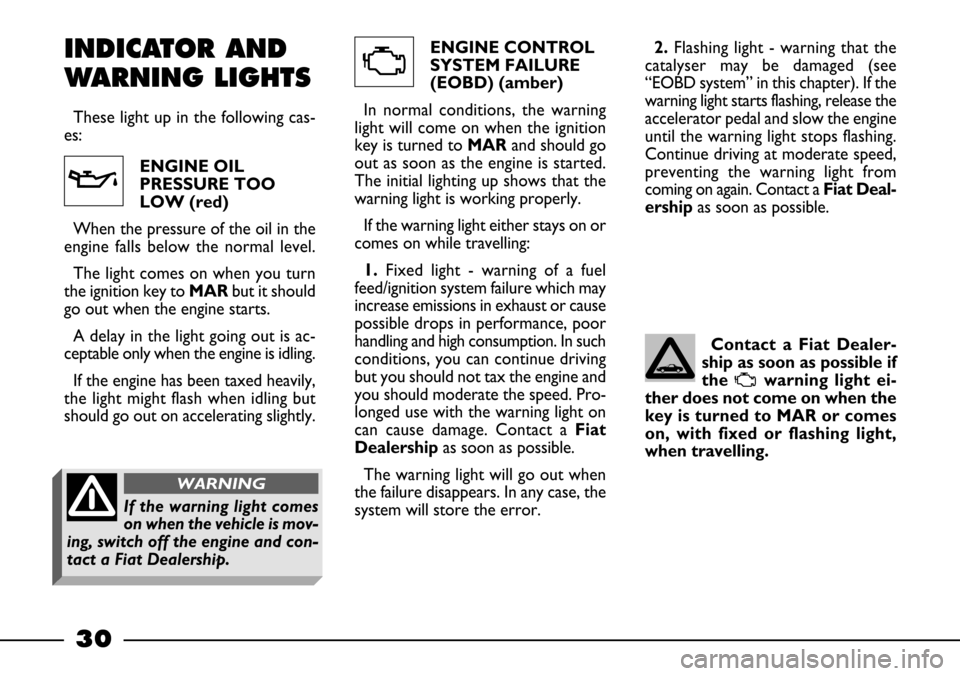
ENGINE CONTROL
SYSTEM FAILURE
(EOBD) (amber)
In normal conditions, the warning
light will come on when the ignition
key is turned to MARand should go
out as soon as the engine is started.
The initial lighting up shows that the
warning light is working properly.
If the warning light either stays on or
comes on while travelling:
1.Fixed light - warning of a fuel
feed/ignition system failure which may
increase emissions in exhaust or cause
possible drops in performance, poor
handling and high consumption. In such
conditions, you can continue driving
but you should not tax the engine and
you should moderate the speed. Pro-
longed use with the warning light on
can cause damage. Contact aFiat
Dealershipas soon as possible.
The warning light will go out when
the failure disappears. In any case, the
system will store the error. ENGINE OIL
PRESSURE TOO
LOW (red)
When the pressure of the oil in the
engine falls below the normal level.
The light comes on when you turn
the ignition key to MARbut it should
go out when the engine starts.
A delay in the light going out is ac-
ceptable only when the engine is idling.
If the engine has been taxed heavily,
the light might flash when idling but
should go out on accelerating slightly.
30
v
U
INDICATOR AND
WARNING LIGHTS
These light up in the following cas-
es:2.Flashing light - warning that the
catalyser may be damaged (see
“EOBD system” in this chapter). If the
warning light starts flashing, release the
accelerator pedal and slow the engine
until the warning light stops flashing.
Continue driving at moderate speed,
preventing the warning light from
coming on again. Contact a Fiat Deal-
ership as soon as possible.
Contact a Fiat Dealer-
ship as soon as possible if
the
Uwarning light ei-
ther does not come on when the
key is turned to MAR or comes
on, with fixed or flashing light,
when travelling.
If the warning light comes
on when the vehicle is mov-
ing, switch off the engine and con-
tact a Fiat Dealership.
WARNING
Page 77 of 170
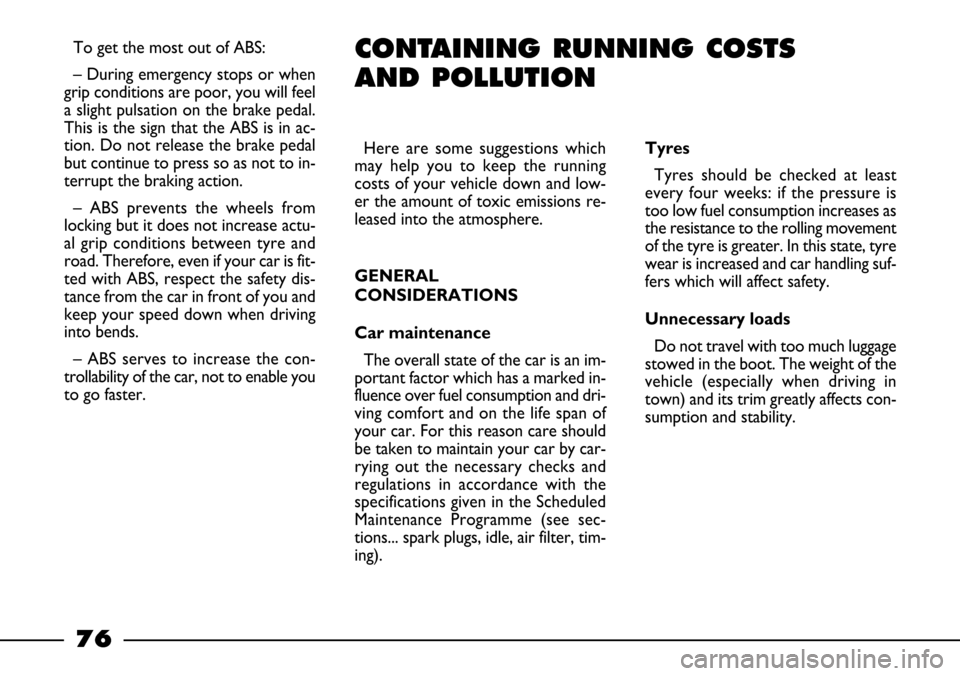
76
Here are some suggestions which
may help you to keep the running
costs of your vehicle down and low-
er the amount of toxic emissions re-
leased into the atmosphere.
GENERAL
CONSIDERATIONS
Car maintenance
The overall state of the car is an im-
portant factor which has a marked in-
fluence over fuel consumption and dri-
ving comfort and on the life span of
your car. For this reason care should
be taken to maintain your car by car-
rying out the necessary checks and
regulations in accordance with the
specifications given in the Scheduled
Maintenance Programme (see sec-
tions... spark plugs, idle, air filter, tim-
ing).
CONTAINING RUNNING COSTS
AND POLLUTION
Tyres
Tyres should be checked at least
every four weeks: if the pressure is
too low fuel consumption increases as
the resistance to the rolling movement
of the tyre is greater. In this state, tyre
wear is increased and car handling suf-
fers which will affect safety.
Unnecessary loads
Do not travel with too much luggage
stowed in the boot. The weight of the
vehicle (especially when driving in
town) and its trim greatly affects con-
sumption and stability. To get the most out of ABS:
– During emergency stops or when
grip conditions are poor, you will feel
a slight pulsation on the brake pedal.
This is the sign that the ABS is in ac-
tion. Do not release the brake pedal
but continue to press so as not to in-
terrupt the braking action.
– ABS prevents the wheels from
locking but it does not increase actu-
al grip conditions between tyre and
road. Therefore, even if your car is fit-
ted with ABS, respect the safety dis-
tance from the car in front of you and
keep your speed down when driving
into bends.
– ABS serves to increase the con-
trollability of the car, not to enable you
to go faster.
Page 78 of 170
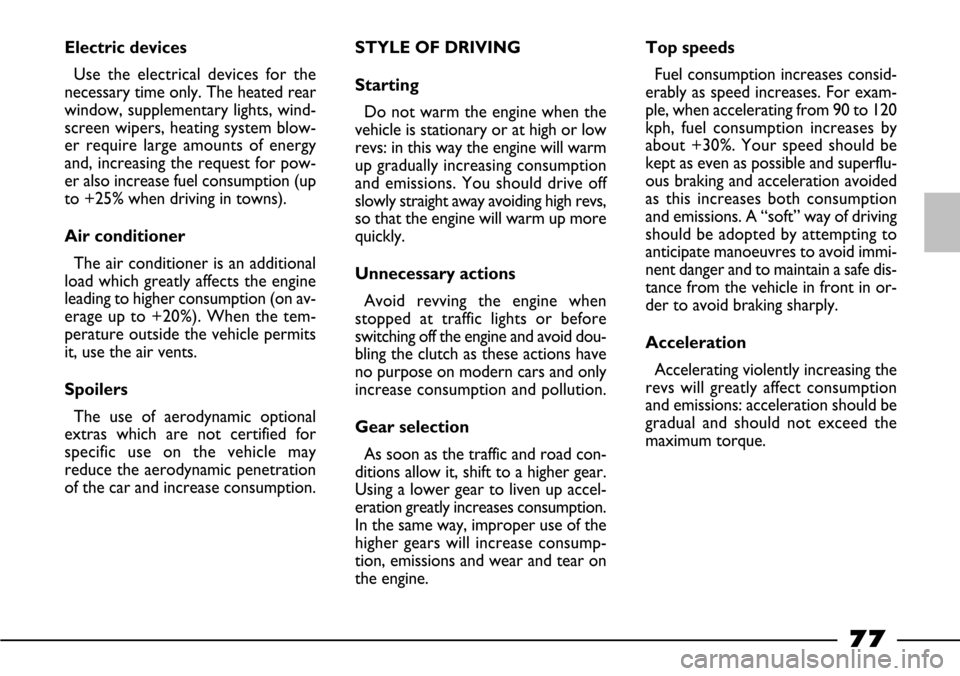
77
Electric devices
Use the electrical devices for the
necessary time only. The heated rear
window, supplementary lights, wind-
screen wipers, heating system blow-
er require large amounts of energy
and, increasing the request for pow-
er also increase fuel consumption (up
to +25% when driving in towns).
Air conditioner
The air conditioner is an additional
load which greatly affects the engine
leading to higher consumption (on av-
erage up to +20%). When the tem-
perature outside the vehicle permits
it, use the air vents.
Spoilers
The use of aerodynamic optional
extras which are not certified for
specific use on the vehicle may
reduce the aerodynamic penetration
of the car and increase consumption.STYLE OF DRIVING
Starting
Do not warm the engine when the
vehicle is stationary or at high or low
revs: in this way the engine will warm
up gradually increasing consumption
and emissions. You should drive off
slowly straight away avoiding high revs,
so that the engine will warm up more
quickly.
Unnecessary actions
Avoid revving the engine when
stopped at traffic lights or before
switching off the engine and avoid dou-
bling the clutch as these actions have
no purpose on modern cars and only
increase consumption and pollution.
Gear selection
As soon as the traffic and road con-
ditions allow it, shift to a higher gear.
Using a lower gear to liven up accel-
eration greatly increases consumption.
In the same way, improper use of the
higher gears will increase consump-
tion, emissions and wear and tear on
the engine.Top speeds
Fuel consumption increases consid-
erably as speed increases. For exam-
ple, when accelerating from 90 to 120
kph, fuel consumption increases by
about +30%. Your speed should be
kept as even as possible and superflu-
ous braking and acceleration avoided
as this increases both consumption
and emissions. A “soft” way of driving
should be adopted by attempting to
anticipate manoeuvres to avoid immi-
nent danger and to maintain a safe dis-
tance from the vehicle in front in or-
der to avoid braking sharply.
Acceleration
Accelerating violently increasing the
revs will greatly affect consumption
and emissions: acceleration should be
gradual and should not exceed the
maximum torque.
Page 79 of 170
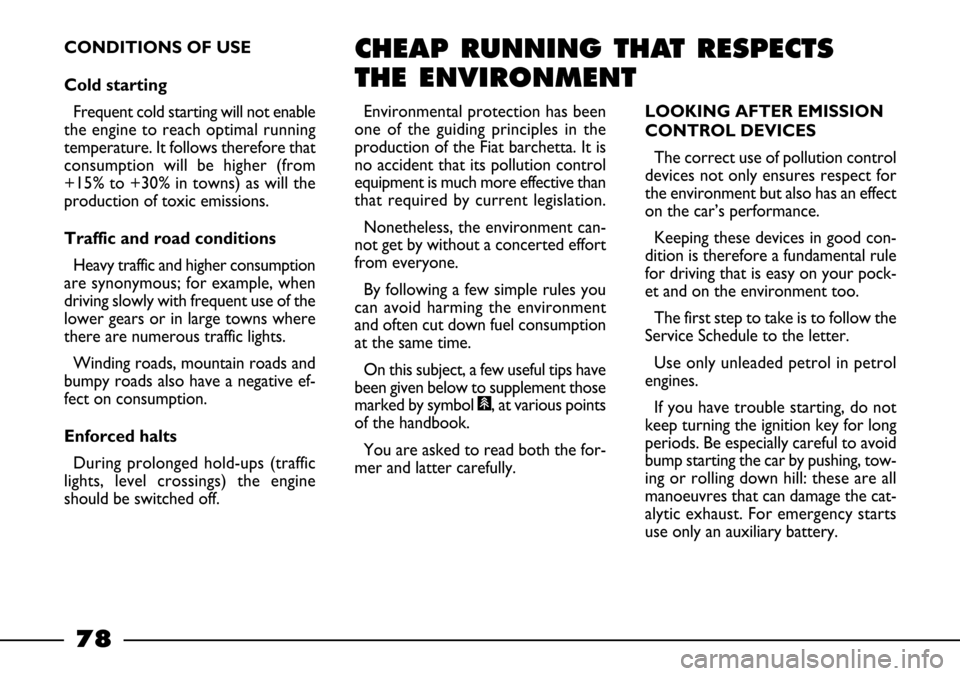
78
CONDITIONS OF USE
Cold starting
Frequent cold starting will not enable
the engine to reach optimal running
temperature. It follows therefore that
consumption will be higher (from
+15% to +30% in towns) as will the
production of toxic emissions.
Traffic and road conditions
Heavy traffic and higher consumption
are synonymous; for example, when
driving slowly with frequent use of the
lower gears or in large towns where
there are numerous traffic lights.
Winding roads, mountain roads and
bumpy roads also have a negative ef-
fect on consumption.
Enforced halts
During prolonged hold-ups (traffic
lights, level crossings) the engine
should be switched off.CHEAP RUNNING THAT RESPECTS
THE ENVIRONMENT
LOOKING AFTER EMISSION
CONTROL DEVICES
The correct use of pollution control
devices not only ensures respect for
the environment but also has an effect
on the car’s performance.
Keeping these devices in good con-
dition is therefore a fundamental rule
for driving that is easy on your pock-
et and on the environment too.
The first step to take is to follow the
Service Schedule to the letter.
Use only unleaded petrol in petrol
engines.
If you have trouble starting, do not
keep turning the ignition key for long
periods. Be especially careful to avoid
bump starting the car by pushing, tow-
ing or rolling down hill: these are all
manoeuvres that can damage the cat-
alytic exhaust. For emergency starts
use only an auxiliary battery. Environmental protection has been
one of the guiding principles in the
production of the Fiat barchetta. It is
no accident that its pollution control
equipment is much more effective than
that required by current legislation.
Nonetheless, the environment can-
not get by without a concerted effort
from everyone.
By following a few simple rules you
can avoid harming the environment
and often cut down fuel consumption
at the same time.
On this subject, a few useful tips have
been given below to supplement those
marked by symbol #, at various points
of the handbook.
You are asked to read both the for-
mer and latter carefully.
Page 136 of 170
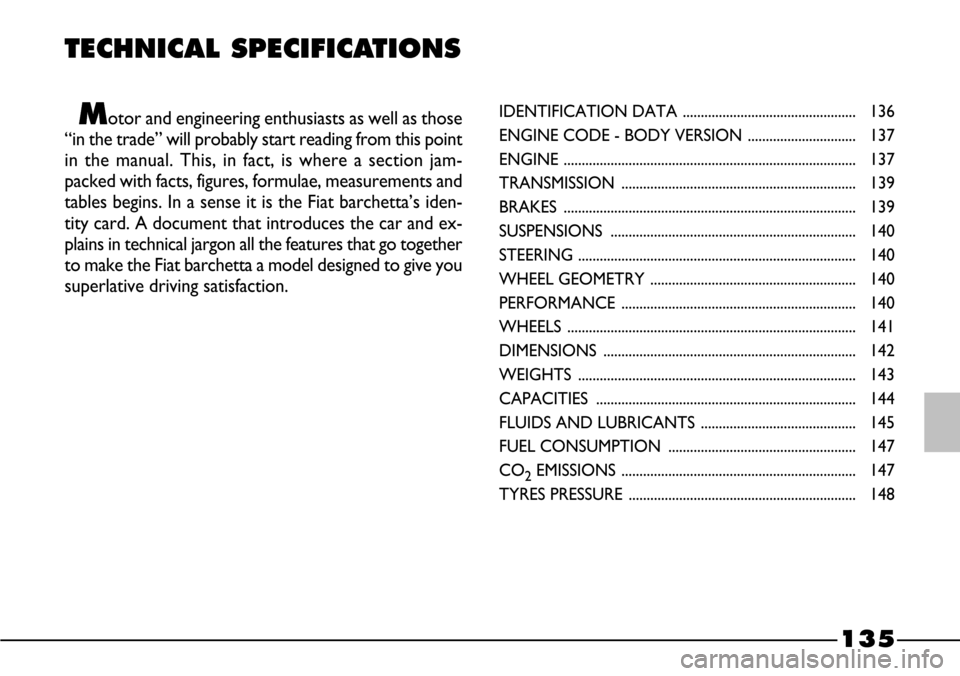
135
TECHNICAL SPECIFICATIONS
Motor and engineering enthusiasts as well as those
“in the trade” will probably start reading from this point
in the manual. This, in fact, is where a section jam-
packed with facts, figures, formulae, measurements and
tables begins. In a sense it is the Fiat barchetta’s iden-
tity card. A document that introduces the car and ex-
plains in technical jargon all the features that go together
to make the Fiat barchetta a model designed to give you
superlative driving satisfaction.IDENTIFICATION DATA ................................................ 136
ENGINE CODE - BODY VERSION .............................. 137
ENGINE ................................................................................. 137
TRANSMISSION ................................................................. 139
BRAKES ................................................................................. 139
SUSPENSIONS .................................................................... 140
STEERING ............................................................................. 140
WHEEL GEOMETRY ......................................................... 140
PERFORMANCE ................................................................. 140
WHEELS ................................................................................ 141
DIMENSIONS ...................................................................... 142
WEIGHTS ............................................................................. 143
CAPACITIES ........................................................................ 144
FLUIDS AND LUBRICANTS ........................................... 145
FUEL CONSUMPTION .................................................... 147
CO
2EMISSIONS ................................................................. 147
TYRES PRESSURE ............................................................... 148
Page 148 of 170
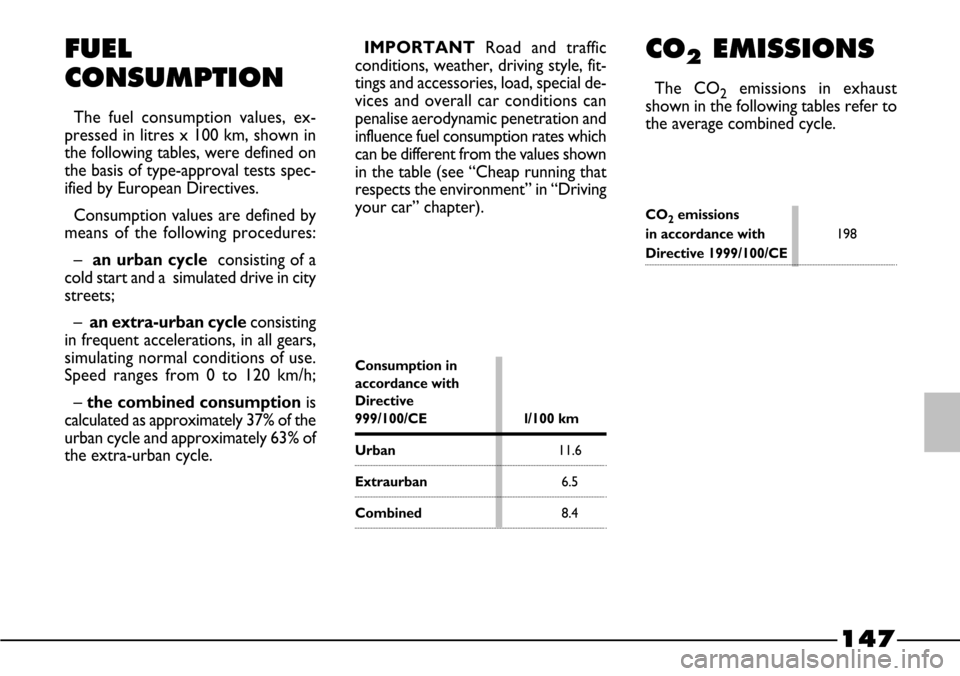
147
FUEL
CONSUMPTION
The fuel consumption values, ex-
pressed in litres x 100 km, shown in
the following tables, were defined on
the basis of type-approval tests spec-
ified by European Directives.
Consumption values are defined by
means of the following procedures:
– an urban cycleconsisting of a
cold start and a simulated drive in city
streets;
– an extra-urban cycleconsisting
in frequent accelerations, in all gears,
simulating normal conditions of use.
Speed ranges from 0 to 120 km/h;
–the combined consumption is
calculated as approximately 37% of the
urban cycle and approximately 63% of
the extra-urban cycle.IMPORTANTRoad and traffic
conditions, weather, driving style, fit-
tings and accessories, load, special de-
vices and overall car conditions can
penalise aerodynamic penetration and
influence fuel consumption rates which
can be different from the values shown
in the table (see “Cheap running that
respects the environment” in “Driving
your car” chapter).
Consumption in
accordance with
Directive
999/100/CE l/100 km
Urban11.6
Extraurban6.5
Combined8.4
CO2EMISSIONS
The CO2emissions in exhaust
shown in the following tables refer to
the average combined cycle.
CO2emissions
in accordance with198
Directive 1999/100/CE
Page 161 of 170
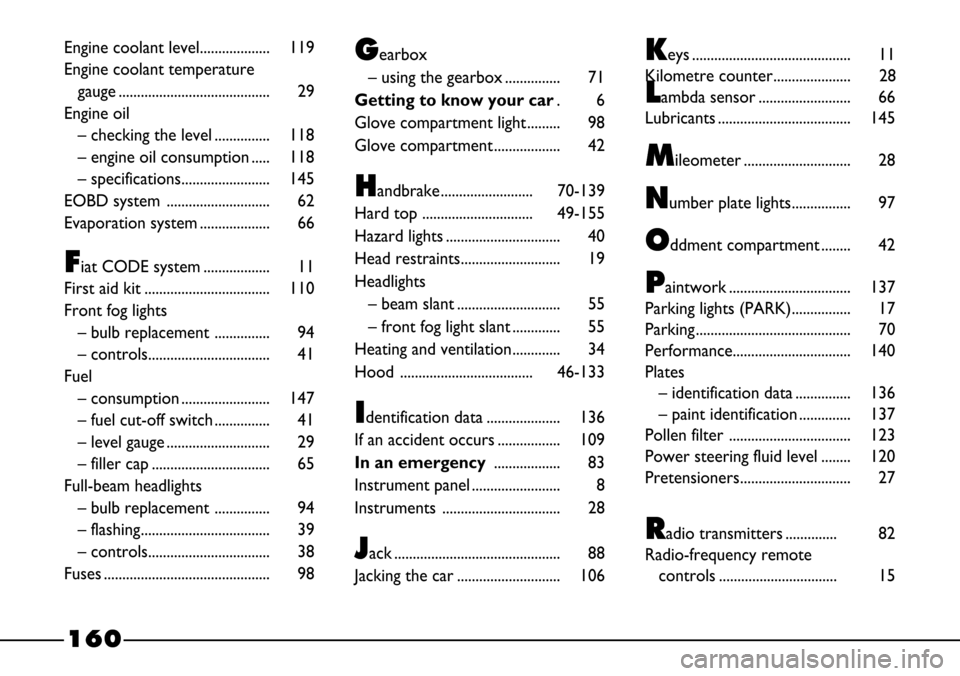
160
Engine coolant level................... 119
Engine coolant temperature
gauge ......................................... 29
Engine oil
– checking the level ............... 118
– engine oil consumption ..... 118
– specifications........................ 145
EOBD system ............................ 62
Evaporation system ................... 66
Fiat CODE system .................. 11
First aid kit .................................. 110
Front fog lights
– bulb replacement ............... 94
– controls................................. 41
Fuel
– consumption ........................ 147
– fuel cut-off switch ............... 41
– level gauge ............................ 29
– filler cap ................................ 65
Full-beam headlights
– bulb replacement ............... 94
– flashing................................... 39
– controls................................. 38
Fuses ............................................. 98
Gearbox
– using the gearbox ............... 71
Getting to know your car.6
Glove compartment light ......... 98
Glove compartment .................. 42
Handbrake......................... 70-139
Hard top .............................. 49-155
Hazard lights ............................... 40
Head restraints........................... 19
Headlights
– beam slant ............................ 55
– front fog light slant ............. 55
Heating and ventilation............. 34
Hood .................................... 46-133
Identification data .................... 136
If an accident occurs ................. 109
In an emergency.................. 83
Instrument panel ........................ 8
Instruments ................................ 28
Jack ............................................. 88
Jacking the car ............................ 106
Keys ........................................... 11
Kilometre counter..................... 28
Lambda sensor ......................... 66
Lubricants .................................... 145
Mileometer ............................. 28
Number plate lights................ 97
Oddment compartment ........ 42
Paintwork ................................. 137
Parking lights (PARK)................ 17
Parking .......................................... 70
Performance................................ 140
Plates
– identification data ............... 136
– paint identification .............. 137
Pollen filter ................................. 123
Power steering fluid level ........ 120
Pretensioners.............................. 27
Radio transmitters .............. 82
Radio-frequency remote
controls ................................ 15